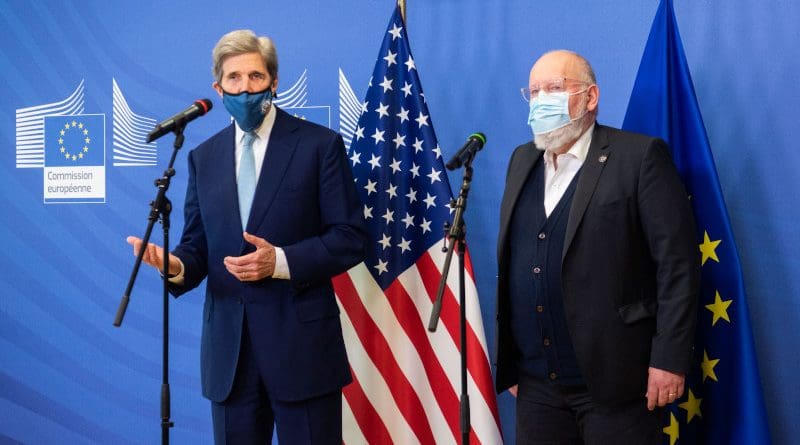US Raises Concerns Over Europe’s Planned Carbon ‘Border Tax’
By EurActiv
By Kira Taylor
(EurActiv) — Implementing a border levy to price carbon-intensive imports and protect European industries will be “extremely complicated,” warned Jonathan Pershing, a member of the US climate envoy’s team.
“I do note that it’s extremely complicated to think about the structure of a border tax,” Pershing told participants at a EURACTIV debate last Friday (7 May).
“I don’t disagree in principle that it has value, but I think that it’s got enormous complexity,” he warned.
The carbon border adjustment mechanism, due to be revealed in July, aims to put a price on imports from countries where it is cheaper to pollute, as a way of protecting European manufacturers facing higher carbon costs.
But it has ruffled feathers around the world. Emerging economies such as Brazil, South Africa, India and China, have criticised the plan as “discriminatory” and unfair to developing nations.
Across the Atlantic, US climate envoy John Kerry warned in March that the EU levy should be envisaged only as a last resort measure, saying: “It does have serious implications for economies, and for relationships, and trade.”
Comparing carbon pricing policies
One issue is how carbon pricing policies outside Europe can be compared with the EU’s in order to work out whether the levy should apply or not.
Unlike Europe, the US has no harmonised price on carbon because it chose not to implement an emissions trading scheme at federal level.
“We do have substantial and rigorous investments and regulatory programmes, but those are somewhat harder to compare and contrast,” Pershing said.
From the start, the European scheme will need to apply to every country that imports goods into the EU in order to be compatible with World Trade Organisation (WTO) rules, confirmed Diederik Samsom, an official who heads the team of EU Green Deal chief Frans Timmermans.
But if imported products have “the same carbon footprint and a reduced carbon footprint, preferably, there’s no adjustment needed,” he explained.
Although this may sound simple, it is more complicated when it comes to how Europe calculates the carbon content of imported products. Manufactured goods may indeed face different carbon prices – whether ‘explicit’ like an emissions trading scheme, or ‘implicit’, like regulations and taxes.
“Considering an excise duty type of tax or VAT type of tax – that’s still one of the options that we are considering in drafting the legislation,” Samsom admitted.
“If there is a difference in carbon footprint, but you have paid at the other side of the Atlantic, your fair share of the price – whether that’s a real, direct price like an ETS, or a direct carbon tax, or a regulatory measure because you can monetise those measures – then also that will be accounted for,” he added.
That could be a solution for the US, but Pershing also voiced concerns about the impact on China or whether African countries, which may not have the capacity to take action on climate change, will be affected.
These are the exact questions that the European Commission is currently trying to solve, Samsom acknowledged.
Pascal Canfin, a French MEP who chairs the European Parliament’s environment committee, seemed confident that there is a workable solution at the end of the rainbow.
“When you put all the package together – WTO compliance, explicit plus implicit, carbon footprint and, of course, the treatments that will be specific for the least developed countries – then at the end of the day, you have something that flies, which is not uncooperative, which is open, which is fair also for climate and for our industries,” he said.
Calls for a carbon border tariff are growing in Europe as the carbon price hit historic highs in recent weeks, reaching €50 per tonne for the first time since the EU carbon market was launched in 2005.
Regulators should not interfere with the carbon price, Timmermans said, so another measure is needed to ensure European companies do not relocate to places where it is cheaper to emit CO2.
“We cannot ask our industries to operate at that level of price, which is needed, without having a level playing field,” Canfin pleaded.
Cooperation on global decarbonisation
Despite heckles raised over the carbon border levy, the US and Europe are keen to present a unified front to help drive global decarbonisation efforts.
The EU-US relationship is significantly friendlier than during the Trump Administration, and both sides are hoping to push international decarbonisation goals in the run-up to COP26 UN climate summit in Glasgow in November.
“We have a bit over half a year to go towards Glasgow, and we have to use every hour of that period to join forces in our climate diplomacy to create a success at the end of the year because only then we can save planet Earth,” said Samsom.
And despite reservation over Europe’s carbon border levy, the US is also considering the idea.
“President Biden, I know, is particularly interested in evaluating the border adjustment mechanism,” Kerry said in an interview on Bloomberg Television. “He wants to look at that and see whether that’s something that we need to deploy.”
For supporters of the levy, it makes sense that the US and EU join hands to support the measure. For instance, introducing some kind of minimum standard for CO2 in products entering the two blocs would put further pressure on China to decarbonise quickly.
“If we put the right standards in place, standards in the European market, to access the European market, standards in the US market to access the US market and the standards are either similar or at least converging … that is just impossible for China to escape,” said Canfin.

